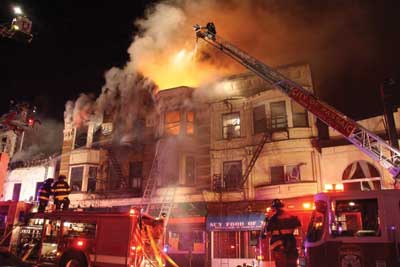By John F. “Skip” Coleman, Technical Editor
It is very easy to take things for granted. Most of us in the fire service know that certain things are there, working as they should, to make our lives easier. We throw a self-contained breathing apparatus on our back, snap in the mask-mounted regulator, and inhale and we get air. Magically, these things work. How? We may not know how, but we do know that almost always, when we throw it on and inhale, we get air. If we are lucky, we are also taught what to do in the rare instance when it doesn’t work. This is one of many such examples in the fire service that almost always works. Sometimes we don’t know exactly how, but it works.
One such “tool” has been starting to present problems recently. Standpipes have been required by law in certain buildings since 1975. Many of these systems have sat idle for quite a while. Sediment, rust, and other “debris” accumulate in some areas from lack of maintenance and inactivity, which can render the device inoperable. One of these problem areas is the pressure reducing valve (PRV) in standpipe systems. If you have ever been on the nozzle end of a broken PRV, you quickly realize something is amiss.
Roundtable question: Has your department experienced failure of a pressure reducing valve? How did you solve the problem? To post your comments, go to fireengineering.com/roundtable.html.
WEBCASTS
Join us for monthly Webcasts featuring the best of Fire Engineering authors and FDIC speakers. On January 9, Major Brian Arnold, Oklahoma City (OK) Fire Department, presents “Skills Drills and Tips for Company Officers.” On January 24, Captain/Training Officer Seth Barker, Big Sky (MT) Fire Department, presents “Preplanning Your Community in the Urban Wildland Interface.” Webcasts are free, but you must register. If you miss this or any other Webcasts, they are archived on emberly.fireengineering.com for six months.
 |
| PHOTO OF THE DAY: Passaic (NJ) firefighters found heavy fire on the second floor of a two-story mixed-use building with a food market on the ground floor. Flames were already extending to exposure D, a three-story ordinary structure containing a beauty salon on the ground floor and apartments above. Four buildings in the row were damaged. A defensive attack included master streams from two tower ladders, a ladder pipe, and a deck gun. (Photo by Ron Jeffers.) See more photos at http://bit.ly/1h1iTNd. Send your Photo of the Day submissions to Peter Prochilo (peterp@pennwell.com). |
FIRE LIFE
In “Life Insurance Contestability,” Fire Life financial guru Diana Palmieri writes: “You should not fear contestability if you have done what you were supposed to do on your insurance application, which was to be honest and provide accurate information. Trying to get lower rates by lying or omitting information only hurts your beneficiaries.” Read more at www.firelife.com.
FEATURED ARTICLES
Eddie Buchanan writes in “Rethinking RECEO VS: Breaking Up with an Old Friend”: “The latest fire dynamic research coming out of the National Institute of Standards and Technology and Underwriters Laboratories has confirmed what some overseas fire departments have shared: Traditional fire suppression tactics in the United States may need revision.” (http://bit.ly/1bZocH8)
Kevin A. Gallagher writes in “Modular Concerns: Reflected Sunlight and Vinyl Siding Distortion”: “As the fire service races to catch up to advances in modern construction, one issue has slipped through the cracks: The issue of vinyl siding distortion caused by reflected heat from high-efficiency windows continues to fly under the radar.” (http://bit.ly/1a7lEHY)
Craig A. Haigh writes in “Staffing: Are We Telling the Right Story?”: “I was chastised about running only three-person companies (not five or six) and how this was dangerous and inefficient. I had been feeling pretty good about running with three people since so many departments in my area had been forced to reduce company staffing numbers, eliminate companies, shutter firehouses, or work with rolling brownouts.” (http://bit.ly/HXOboX)
Christopher Huston writes in “Mitigating Class C Fires”: “Your engine company has been called to respond to a piece of equipment on fire at a manufacturing plant. Since this scenario involves electrical equipment on fire, how would you extinguish this fire with the tools you have on your engine?” (http://bit.ly/1isxBf6)
Jarrod Sergi writes in “Lack of Ventilation Because of a Lack of Performance”: “I have heard firefighters talk about the incident commander’s decision to send a crew to the roof, with many saying, ‘Our chiefs just don’t like us to vertically vent.’ ” (http://bit.ly/Hr4dap)
COMMUNITY MEMBER OF THE MONTH |
||
|
Name: Derek Grafton. Department: Eugene (OR) Fire Department. Rank: lieutenant. Years of public service: 17. Agency structure: paid department. |
 |
|
Fire Engineering Archives

